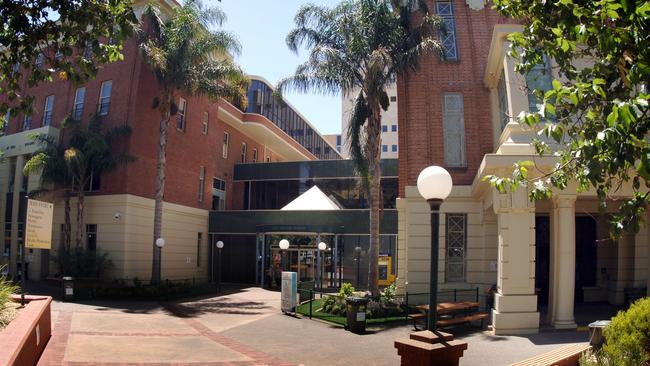Second RAH chemotherapy error discovered after inquiry into the underdosing of leukaemia patients
A SECOND dosage error potentially affecting nine Royal Adelaide Hospital patients with aggressive lymphomas was discovered in September — a month after an inquiry began into the underdosing of 10 seriously ill leukaemia patients.

SA News
Don't miss out on the headlines from SA News. Followed categories will be added to My News.
PREVIOUS COVERAGE ON THIS CASE:
- How ‘typo’ denied cancer patients full treatment
- Chemo cancer error: Patient paid, then gagged
- Patient seethes over bungle
- Inquiry called into wrong dosage
A SECOND dosage error potentially affecting nine Royal Adelaide Hospital patients with aggressive lymphomas was discovered in September — a month after an inquiry began into the underdosing of 10 seriously ill acute myeloid leukaemia patients.
The new error was uncovered by Professor Villis Marshall’s independent review of the chemotherapy dosing error that affected 10 patients, which has condemned the RAH haematology unit as disorganised and sometimes dysfunctional.
SA Health Minister Jack Snelling said the “similar but separate” transcription error related to high-intensity protocols for treating aggressive lymphomas and had been in the RAH system since 2005.
All but one patient had been correctly treated, however that patient — who was in remission and who health officials attempted to contact yesterday — had been given half the recommended steroid dose.
Mr Snelling said he was very concerned at the second mistake, which was picked up during a review of protocols after the chemotherapy bungle was discovered.
But he was more angry at the RAH’s delayed response to the chemotherapy error, which resulted in a patient at the Flinders Medical Centre — which used RAH protocols for the treatment of acute myeloid leukaemia — being wrongly dosed two days later.
“That is completely unacceptable,” he said. “That’s what I’m particularly angry about. Mistakes will happen in a health system, but what you do expect is that when a mistake is made, the appropriate procedures are taken.”
Mr Snelling did not accuse the RAH of a cover-up, but said subsequent investigations would determine whether this had occurred.
“I think anyone reading the report may well infer that,” he said.
“Any determination on that will have to go through the disciplinary investigations to determinewhat culpability there was.”
The report recommended consideration be given to referring a handful of doctors — believed to include senior clinicians — to the Australian Health Practitioner Regulation Agency, which was previously the doctors registration board.
“The review panel formed the view that the clinical conduct of certain clinicians demonstrated a lack of adequate knowledge, skill, care and judgment,” Professor Marshall found.
He asked the chief executive officer of the Central Health Network, Julia Squire, to consider referring “relevant clinicians” to the board, which has the power to deregister them.
Professor Marshall told The Advertiser he believed there were issues with individuals at the RAH and the FMC but the response was with the department.
“It’s a small number (of doctors),” he said
Mr Snelling said he would support their referral to the board if it was believed to be warranted.
“The recommendation is for her to consider it,” he said. “I don’t want to in any way prejudice her decision.”
The report uncovered alarming failures in workplace practices and governance at the RAH which Professor Marshall called “disorganised, ad hoc and in some cases, dysfunctional”.
The underdosing was caused by a series of significant clinical governance failures within the RAH Haematology unit, including failure to follow routine clinical processes relating to patient drug protocols. Certain clinical staff had failed to comply with “incident management” procedures which should have been enacted when the mistake was discovered.
Mr Snelling there were clearly issues with governance at the RAH that had to be fixed as a matter of urgency.
The mistake entered the system when a project officer presented a draft to a senior haematologist for checking at the end of a “busy clinic” day. The project officer wanted it cleared because he was going on leave the next day. The senior clinician signed off without picking up the mistake, and it was circulated in a group email.
FMC then adopted the RAH protocols without invoking its own internal checking procedures.
“It’s a failure of adherence to standard operating procedures,” Professor Marshall said. “The sorts of things that would not, for example, be acceptable to the airline industry.”
He said systems were tested when something went wrong.
“It’s a bit like driving a car with four bald tyres — if things go all right, nothing goes wrong. It’s when you get under pressure that problems occur.”
Mr Snelling said compensation for the acute myeloid leukaemia patients given the wrong dose was a separate issue but the Government would be a model litigant if patients sued.
Professor Marshall, who briefed families on the contents of the report before its release, said the error was “sad” because the patients concerned had a serious form of cancer and the likelihood of a cure was not high, no matter what the treatment.
“It may well have been looked at as almost a last chance,” he said. “To then find they got the wrong dose naturally made them very worried because they thought it might have reduced their chances of a cure or a good remission.”
He said that with proper treatment, only three out of the ten would have a good outcome but patients who relapsed would believe the lower dose contributed.
“It seems perfectly reasonable to me that that’s how the patients and their family would see it,” he said.
He said it was impossible to say how much medical harm the lower dose had done.
“Clearly, the knowledge that they had a reduced dose did bring about this incredible distress.”


